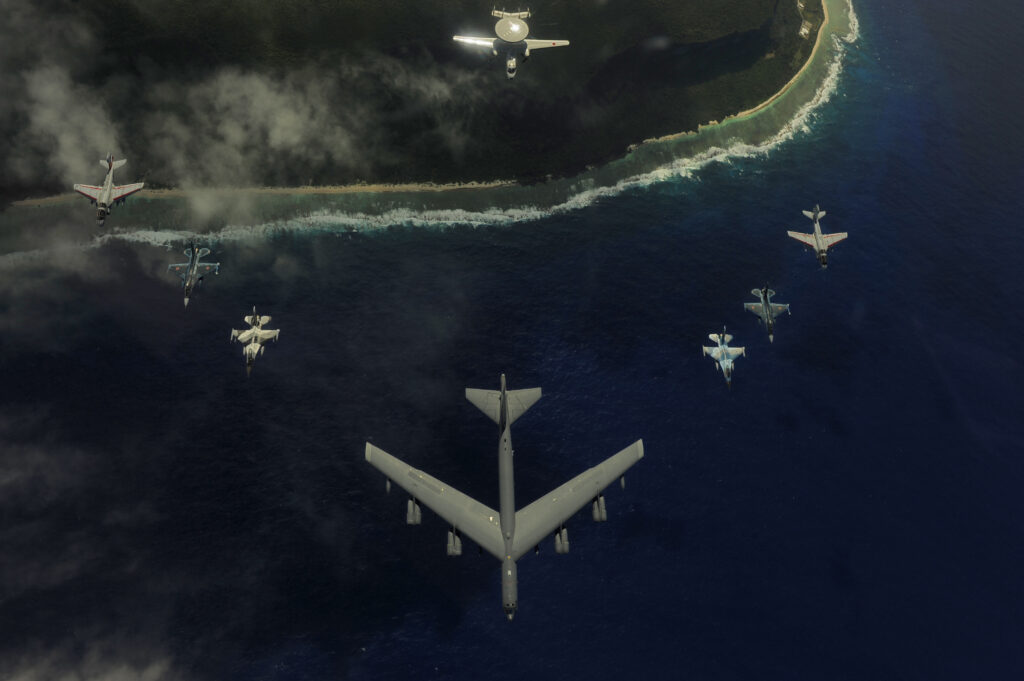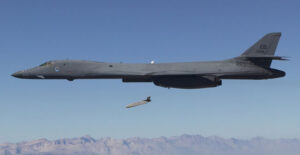The Nuclear Bomber: Fighting Conflated Deterrence in the 21st Century
Posted on
Our coverage of deterrence and the roles of using weapons for signaling continues to elicit strong and pertinent reactions from readers and practitioners in these days when North Korea, China and Russia so robustly challenge the United States and its allies. As you read on, you’ll see the author of this latest piece is a nuclear certified weapons officer attached to the 492nd Fighter Squadron stationed at Royal Air Force Lakenheath in the UK. Mike Benitez offers a subtle and intriguing argument that using conventional or dual-use platforms (those that can deliver conventional and nuclear weapons) can undermine the very message we intend to send, Read on. The Editor.
The pages of Breaking Defense have recently been filled with a fine and vigorous debate about whether bombers work as nuclear signaling tools that deter competitors and enemies. But the heart of the deterrence issue is really not if it does or does not work; the question today is the clarity of the message through the signal.
There is little doubt bomber presence is a key part of both assurance and deterrence, but assuming that this presence is a nuclear deterrent versus a conventional deterrent is a large assumption on its own. With injecting a visually synonymous input in the form of a bomber, and an output that is indistinguishable, how would one know the message received was the one intended?
The assumption of specified deterrence is best seen through another part of the nuclear triad: the Intercontinental Ballistic Missile (ICBM). In 2007, during the pivot from Iraq back to Afghanistan (and the ever-expanding Global War on Terror), Washington discussed ideas of arming ICBMs with conventional warheads. The resulting strategic and political arguments for these so-called Prompt Global Strike ended in 2011 after it was rationally argued that a conventional ICBM launch would look exactly like a nuclear-equipped ICBM launch. The potential for misinterpretation and resulting world conflict escalation greatly out-weighed the benefit of fielding the capability. Though the conventional ICBM comparison is the polar opposite in perceived assumption, the message of conflated deterrence is the same.
The other potential signaling Adam Lowther alludes to in his recent Breaking Defense commentary is using “nuclear capable bombers.” To illustrate the point of messaging with nuclear verbology, the phrase was also recently splashed across the Internet in the form of “US to send nuclear-capable B-52 warplanes to bomb ISIS.” While no one reasonably believes that B-52s were deployed to the Middle East for their nuclear capability, the point is that the distinction between deterrence and embellishment is not necessarily the input (i.e. the bomber); it must be combined with information operations and diplomacy.
Compounding this, it is well-advertised that bomber deterrence missions deploy and fly unarmed. This is an enormous distinction between past and present nuclear deterrence and points to a nation’s nuclear resolve because this decision carries risk. During the Cold War, in the dawn before the ICBM, bombers routinely flew deterrence and airborne alert missions while carrying live nuclear weapons. The policy was abruptly ended on January 21, 1968 when a B-52 with a cabin fire crashed near Thule Air Base, Greenland. The nuclear payload, consisting of four hydrogen bombs, was damaged by associated conventional bomb explosions that ignited in the crash, creating a nuclear contaminated crash site. The risk of a nuclear incident via a safety mishap while carrying these warheads made the risk politically unappetizing; 50 years later the global conscience (and national politics) makes this even less viable.
Historically, deterrence appears to be successful when the power practicing it imposes its will upon a nation of equal values, morals, ethics, and political fortitude. But nuclear deterrence requires a unique signal that must be both genuine and clear. With a seemingly waning appetite to proliferate or use nuclear weapons in the world today, nuclear deterrence appears nothing more than an illusion; a magic trick of military power. That is not to say that it is not still viable, but today there are an ever-increasing number of ways that the power of nuclear deterrence can be squandered.
The issue of believability is made worse by an unclear deterrence methodology. What makes a bomber a clearer signal than the hundreds of nuclear-capable multi-role fighters we have today? I believe it is simply distinction of mission. The longer we use B-52s for Operation INHERENT RESOLVE, for example, the more the B-52’s clout of nuclear deterrence will subside to conventional deterrence. The near-sighted decision to deploy the B-52s creates positive tactical aspects that fit nicely within military leadership’s tenure of command, but this will create long-term strategic problems of conflated deterrence that are not easily undone. from a messaging and signal perspective is the B-52 a nuclear bomber doing conventional missions, or a conventional bomber flying nuclear deterrence?
Would this perception be any different if they had been used extensively the past seven years in the Middle East, as the B-1 has? I think it would. If conflation of deterrence is allowed to permeate through poor bomber strategy, the U.S. risks erosion of its nuclear power messaging. This in turn increases the risk of nuclear escalation. That is the conundrum of the nuclear multi-role fighter (and why I believe a dual-capable F-35 is fiscally irresponsible without a sound nuclear strategy). Even worse, the methods to regain nuclear resolve to bolster the message of nuclear deterrence have also been removed over the years. Today nuclear deterrence should be thought of as a national resource with attributes of a natural resource.
Nuclear deterrence hasn’t changed much in 50 years, but the world has. Deterrence requires strategic comprehension by the leaders we are trying to influence of the second and third-order effects that decisions like this induce, and an avenue to make those assertions known to those leaders. Education in nuclear strategy is the beginning, and Dr. Lowther and the School of Advanced Nuclear Deterrence Studies are forming the nucleus of that piece. Perhaps the 21st century is revealing an entirely new nuclear paradigm: increased nuclear risk aversion increases the risk for conflated deterrence and the appetite for sincere assurance is mainly seen in the palatability of true nuclear deterrence.
Lowther states, “value of the bomber force for sending political signals is clear and convincing.” I completely agree. But, how do we show our nuclear resolve, the premise of nuclear deterrence, when the signal can be interpreted as conventional deterrence? How do we evolve nuclear deterrence in an equally evolving world? The message, and signal, must remain clear. Is the bomber still that message? I believe it should be, but its ability is slowly eroding due to conflated deterrence from competing interests that counter mission distinction.
Mike Benitez is a US Air Force weapons officer assigned to the nuclear-capable 492nd Fighter Squadron, Royal Air Force Lakenheath, UK. Awarded the Distinguished Flying Cross last year, Benitez has served overseas in five combat deployments and has flown 273 combat missions. He is a graduate of the US Air Force Weapons School, is nuclear certified and will soon be a legislative fellow. The views expressed in this article are those of the authors and do not reflect the official policy or position of the Air Force, Defense Department, or the US Government.
Subscribe to our newsletter
Promotions, new products and sales. Directly to your inbox.



